Catalytic Technologies for Water and Air Cleaning
The project involves the development of catalysts for the reduction of inorganic ions in water and wastewater and for the oxidation of volatile organic compounds (VOCs) and carbon monoxide in air and gaseous streams.
Catalytic Reduction of Inorganic Ions
The increasing concentration of chemicals in groundwater and the increasingly demanding quality standards for drinking water, generate the urgent need for improved technologies and processes for water remediation, in order to protect the environment and human health.
Catalytic reduction has been suggested as a promising technology to remove anions from water sources, without the formation of solid or liquid wastes, or possible bacterial contaminations. In this topic, the catalytic reduction of ions (such as nitrate, bromate and perchlorate) with hydrogen is studied in a systematic way, focusing on the use of carbon-supported metal catalysts.
Pd-Cu supported on basic carbon materials was found to be the most active and selective catalyst. This catalytic system performed equally well in the reduction of bromate ions.
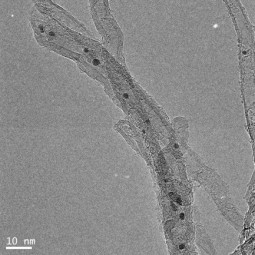
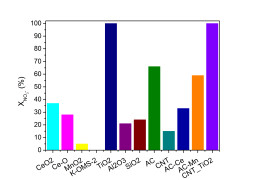


J. Restivo, O.S.G.P. Soares, J.J.M. Órfão, M.F.R. Pereira. Catalytic reduction of bromate over monometallic catalysts on different powder and structured supports. Chemical Engineering Journal, 309, 197–205, 2017
J. Restivo, O.S.G.P. Soares, J.J.M. Órfão, M.F.R. Pereira. Metal assessment for the catalytic reduction of bromate in water under hydrogen. Chemical Engineering Journal, 263, 119-126, 2015
O.S.G.P. Soares, J.J.M. Órfão, M.F.R. Pereira. Nitrate reduction with hydrogen in the presence of physical mixtures with mono and bimetallic catalysts and ions in solution. Applied Catalysis B: Environmental, 102, 424-432, 2011
O.S.G.P. Soares, J.J.M. Órfão, M.F.R. Pereira. Nitrate reduction catalyzed by Pd-Cu and Pt-Cu supported on different carbon materials. Catalysis Letters, 139, 97-104, 2010
O.S.G.P. Soares, J.J.M. Órfão, M.F.R. Pereira. Bimetallic catalysts supported on activated carbon for the nitrate reduction in water: optimization of catalysts composition. Applied Catalysis B: Environmental, 91, 441-448, 2009
Catalytic Oxidation of VOCs
Volatile organic compounds (VOCs) are emitted from a wide range of industrial processes and transportation activities and have a major contributor to air pollution because of their toxic and malodorous nature and their involvement in ozone depletion and smog formation. Thermal oxidation of VOCs needs to operate in a range of temperatures between 700 and 1000ºC, which leads to NOx production from the N2 present in air. In the case of catalytic oxidation, the operation temperature decreases to around 250–500ºC, therefore, NOx production is much lower, and less energy is needed to preheat the stream. Ideally the products obtained are CO2 and water. The performance of this process critically depends on the type of catalyst, which is a function of the gaseous effluent to be treated (composition, flow-rate, presence of poisons or/and inhibitors in the gas stream, and inlet temperature constraints).
Cryptomelane-manganese oxides based catalysts, supported gold nanoparticles, exotemplated and mixed metal oxides, and monoliths coated with manganese oxides, have been successfully used as catalysts.
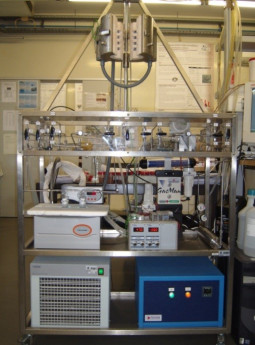
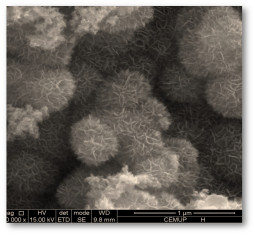
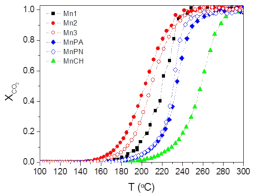
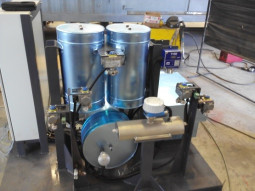
S.A.C. Carabineiro, M. Konsolakis, G.E.N. Marnellos, M.F. Asad, O.S.G.P. Soares, P.B. Tavares, M.F.R. Pereira, J.J. De Melo Órfão, J.L. Figueiredo. Ethyl acetate abatement on copper catalysts supported on ceria doped with rare earth oxides. Molecules, 21, 2016
S.A.C. Carabineiro, X. Chen, M. Konsolakis, A.C. Psarras, P.B. Tavares, J.J.M. Órfão, M.F.R. Pereira, J.L. Figueiredo. Catalytic oxidation of toluene on Ce-Co and La-Co mixed oxides synthesized by exotemplating and evaporation methods. Catalysis Today, 244, 161-171, 2015
X. Chen, S.A.C. Carabineiro, S.S.T. Bastos, P.B. Tavares, J.J.M. Órfão, M.F.R. Pereira, J.L. Figueiredo. Catalytic oxidation of ethyl acetate on cerium-containing mixed oxides. Applied Catalysis A: General, 472, 101-112, 2014
V.P. Santos, O. Soares, J.J.W. Bakker, M.F.R. Pereira, J.J.M. Orfao, J. Gascon, F. Kapteijn, J.L. Figueiredo. Structural and chemical disorder of cryptomelane promoted by alkali doping: Influence on catalytic properties. Journal of Catalysis, 293, 165-174, 2012
V.P. Santos, M.F.R. Pereira, J.J.M. Órfão, J.L. Figueiredo. The role of lattice oxygen on the activity of manganese oxides towards the oxidation of volatile organic compounds. Applied Catalysis B: Environmental, 99, 353-363, 2010
Catalytic Oxidation of CO
Gold catalysts have been successfully used for CO oxidation, as well as in the water-gas shift reaction (CO + H2O → CO2 + H2). Moreover, gold is more selective than Pt and other PGMs for the oxidation of CO in the presence of H2 (PROX), is nearly insensitive to CO2, and its activity is enhanced by water. Thus, Au catalysts are good candidates for H2 production and purification. We have been focusing our attention on the catalyst preparation methods in order to achieve high activity at low temperatures.
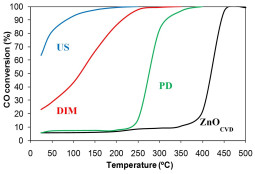
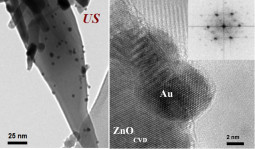

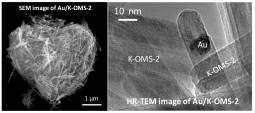
S.A.C. Carabineiro, V.P. Santos, M.F.R. Pereira, J.J.M. Órfão, J.L. Figueiredo. CO oxidation over gold supported on Cs, Li and Ti-doped cryptomelane materials. Journal of Colloid and Interface Science, 480, 17-29, 2016
V.P. Santos, S.A.C. Carabineiro, J.J.W. Bakker, O.S.G.P. Soares, X. Chen, M.F.R. Pereira, J.J.M. Órfão, J.L. Figueiredo, J. Gascon, F. Kapteijn. Stabilized gold on cerium-modified cryptomelane: Highly active in low-temperature CO oxidation. Journal of Catalysis, 309, 58-65, 2014
S.A.C. Carabineiro, N. Bogdanchikova, M. Avalos-Borja, A. Pestryakov, P.B. Tavares, J.L. Figueiredo. Gold supported on metal oxides for carbon monoxide oxidation. Nano Research, 4, 180-193, 2011
V.P. Santos, S.A.C. Carabineiro, P.B. Tavares, M.F.R. Pereira, J.J.M. Órfão, J.L. Figueiredo. Oxidation of CO, ethanol and toluene over TiO2 supported noble metal catalysts. Applied Catalysis B: Environmental, 99, 198-205, 2010
S.A.C. Carabineiro, B.F. MacHado, R.R. Bacsa, P. Serp, G. Drai_, J.L. Faria, J.L. Figueiredo. Catalytic performance of Au/ZnO nanocatalysts for CO oxidation. Journal of Catalysis, 273, 191-198, 2010




